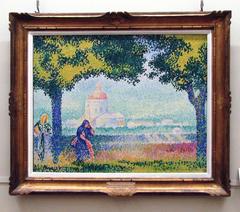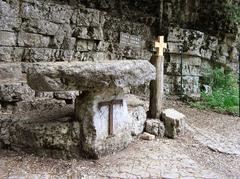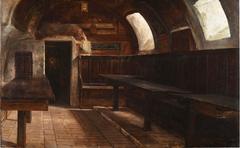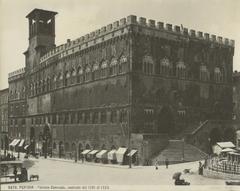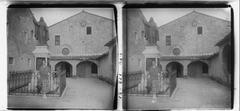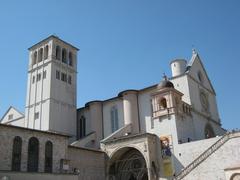Visiting Bosco di San Francesco: Hours, Tickets, and Historical Insights
Date: 23/07/2024
Introduction
Nestled in the picturesque town of Assisi, Italy, the Bosco di San Francesco, or the Forest of Saint Francis, stands as a testament to the enduring legacy of Saint Francis of Assisi, the patron saint of animals and the environment. This serene woodland area is imbued with both historical and spiritual significance, drawing visitors from around the globe who seek to connect with nature and history in a profound way. The forest’s origins trace back to the early 13th century, when Saint Francis himself would retreat to this tranquil haven for prayer and contemplation. Over the centuries, the Bosco di San Francesco has evolved, reflecting the changing times while maintaining its core spiritual essence. From its medieval significance as a sanctuary for Franciscan monks to its modern-day restoration efforts by the Italian environmental organization Fondo Ambiente Italiano (FAI), the forest remains a vital part of Assisi’s cultural and natural landscape (FAI). This comprehensive guide aims to provide you with all the essential information for visiting Bosco di San Francesco, including its history, visiting hours, ticket information, and travel tips, ensuring a memorable and enriching experience.
Table of Contents
- Introduction
- Historical Background
- Visitor Information
- Cultural and Religious Significance
- Archaeological Discoveries
- Integration with the Local Community
- Visitor Experience
- FAQ
- Conclusion
- Sources
Historical Background
Origins and Early History
The origins of the Bosco di San Francesco date back to the early 13th century when Saint Francis himself would retreat to this forest for prayer and contemplation. The forest was part of the land owned by the Benedictine monks of the nearby San Benedetto Abbey, which was established in the 11th century (FAI).
Medieval Significance
During the medieval period, the Bosco di San Francesco served as a spiritual haven for Saint Francis and his followers. The forest’s seclusion provided an ideal environment for meditation and connection with nature, central to Franciscan spirituality. The area around Assisi, including the Bosco, became a focal point for the Franciscan Order, emphasizing simplicity, poverty, and a deep respect for all living creatures. The forest’s significance is underscored by its proximity to the Basilica of Saint Francis, a UNESCO World Heritage Site, which houses the saint’s tomb (UNESCO).
Renaissance and Baroque Periods
During the Renaissance and Baroque periods, the Bosco di San Francesco continued to be a place of pilgrimage and reflection. Several chapels and hermitages were constructed, including the Church of Santa Croce, built in the 14th century and later renovated in the Baroque style. This church, located within the forest, served as a spiritual center for those seeking solace and inspiration in the footsteps of Saint Francis (FAI).
Modern Restoration and Conservation
In the 20th century, the Bosco di San Francesco faced challenges due to neglect and environmental degradation. Recognizing the historical and ecological importance of the forest, the Italian environmental organization Fondo Ambiente Italiano (FAI) undertook a major restoration project in 2008. The project aimed to restore the forest’s natural habitat, preserve its historical structures, and make it accessible to the public. The restoration included the clearing of invasive species, the planting of native trees, and the repair of ancient pathways and buildings (FAI).
Visitor Information
Visiting Hours
The Bosco di San Francesco is open to visitors throughout the year. Typical visiting hours are from 10:00 AM to 6:00 PM, but it’s advisable to check the official FAI website for the most current information and any seasonal changes.
Ticket Prices
Admission to the Bosco di San Francesco is reasonably priced, with tickets typically costing around €6 for adults. Discounts are often available for children, students, and seniors. FAI members may enjoy free or reduced admission.
Travel Tips
- Best Time to Visit: Spring and autumn offer the most pleasant weather, making these seasons ideal for visiting the Bosco di San Francesco.
- Getting There: The forest is accessible by car, and parking is available nearby. For those using public transport, buses run regularly from the center of Assisi.
- What to Bring: Comfortable walking shoes, water, and a camera to capture the stunning scenery.
Cultural and Religious Significance
The Bosco di San Francesco holds immense cultural and religious significance. It is a living testament to the legacy of Saint Francis and his teachings on the harmony between humans and nature. The forest is a place where visitors can experience the tranquility and beauty that inspired Saint Francis’s Canticle of the Creatures. The Bosco also hosts various cultural and religious events, including guided tours, educational programs, and spiritual retreats, promoting the values of peace, simplicity, and environmental stewardship (FAI).
Archaeological Discoveries
Recent archaeological excavations in the Bosco di San Francesco have uncovered significant findings that shed light on the area’s historical use. Artifacts dating back to the Roman period have been discovered, indicating that the forest was inhabited or utilized long before the time of Saint Francis. These discoveries include remnants of ancient agricultural terraces, pottery, and tools, providing valuable insights into the region’s historical landscape and its evolution over the centuries (FAI).
Integration with the Local Community
The Bosco di San Francesco is not only a historical and natural site but also an integral part of the local community in Assisi. The forest’s restoration has fostered a sense of pride and stewardship among residents, who actively participate in its conservation and promotion. Local schools and organizations collaborate with FAI to organize educational activities and volunteer programs, ensuring that the Bosco remains a vibrant and well-maintained space for future generations (FAI).
Visitor Experience
Today, the Bosco di San Francesco offers visitors a unique opportunity to immerse themselves in the natural and spiritual heritage of Assisi. The forest features well-marked trails leading to various points of interest, including the Church of Santa Croce, the ancient mill, and panoramic viewpoints overlooking the Umbrian countryside. Informational panels along the trails provide historical context and insights into the flora and fauna of the forest. Additionally, the Bosco is equipped with facilities such as picnic areas, restrooms, and a visitor center, making it accessible and enjoyable for all ages (FAI).
FAQ
What are the visiting hours for Bosco di San Francesco? The typical visiting hours are from 10:00 AM to 6:00 PM. Check the official FAI website for the most current information and any seasonal changes.
How much do tickets to Bosco di San Francesco cost? Tickets typically cost around €6 for adults. Discounts are available for children, students, and seniors. FAI members may have free or reduced admission.
What should I bring when visiting Bosco di San Francesco? Comfortable walking shoes, water, and a camera to capture the stunning scenery are recommended.
Conclusion
The Bosco di San Francesco is a remarkable example of how historical preservation and environmental conservation can coexist. Its rich history, cultural significance, and natural beauty make it a must-visit destination for those seeking to connect with the legacy of Saint Francis and the timeless allure of the Umbrian landscape. Through ongoing efforts by organizations like FAI and the local community, the Bosco di San Francesco continues to thrive as a sanctuary of peace, reflection, and inspiration (FAI).
Call to Action
Stay updated on the latest events and information about Bosco di San Francesco by following us on social media or downloading our mobile app Audiala. Check out our other articles on Assisi historical sites for more travel inspiration.
Sources
- FAI. Bosco di San Francesco. Retrieved from https://www.fondoambiente.it/luoghi/bosco-di-san-francesco
- UNESCO. Basilica of Saint Francis of Assisi. Retrieved from https://whc.unesco.org/en/list/990

